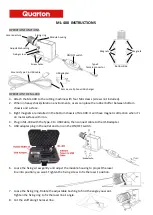
iSYSTEM, March 2017
3/66
There are three status LEDs on the iC5500 Base Unit. The LEDs inform the user of the current status of the
iC5500. Their meaning is:
– When lit, the unit is turned on
R – When lit, the target application being controlled is running
F – When lit, the unit is free for communication, i.e. winIDEA can connect to it.
Valid input voltage range for all debug signals is between 1.8 - 5.5V
All debug signals have a 47E series termination/protection resistors and ESD protection devices. All inputs have
10K pull-up resistor, except TDO input which has a 10K pull-down. Bidirectional debug signals have pull-up
resistors: TMS and TDI have 10K, RESET has a 1K. The latter is buffer-driven to prevent current flow into the
unpowered iC5500 from a powered target board.
Debug signals are additionally protected with 100mA resettable fuses.
The TAR_VREF (target reference voltage) pin has a 100K input impedance.
Connecting debug cable adapter to the DTM
Debug cable adapters, which come without any cable attached are used in conjunction with a connecting 25 cm
long 40-pin flat cable (which comes delivered with the iC5500) and connect always to DTM #1 connector
located on top of the iC5500.
Example of the debug cable adapter for Cortex architecture without the attached cable
25 cm 40-pin flat cable
Connecting guidelines for debug cable adapters delivered without pre-attached flat cable:
Be gentle when connecting one connector to the other! Do not use any excessive force, observe the
orientation key and connector notches!
First, connect the 25 cm 40-pin flat cable to the iC5500 DTM #1 connector.
The cable should be facing away from the iC5500 Base Unit with the red (edge) wire on the side of the
DTM #1 marking.
Align the orientation key/notch of the cable connector with the notch on the iC5500 40-pin connector
marked with #1.
Press the cable connector carefully straight down until the latches lock. Do not press only on one side of
the connector as this can (in worst case) bend the corner pins of the DTM #1 connector.
Next, connect the debug cable adapter to the other side of the 25 cm 40-pin flat cable.
Align the orientation key/notch on the 40-pin debug cable adapter connector with the connector on the
40-pin flat cable.
Press the cable carefully straight down until the latches lock. Do not press only on one side of the
connector as this can (in worst case) bend the corner pins of the adapter’s connector.




































